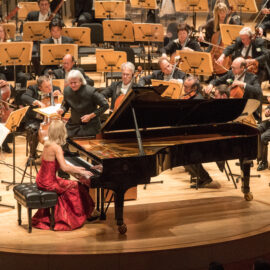The Roaring Twenties!
When historians talk about “cultural ferment,” watch out: mayhem, social upheaval and armed conflict will soon enter the conversation. But to students and critics of the arts, social ferment is a bit more like biological fermentation, producing beauty from decay. Extraordinarily difficult times can produce extraordinarily great art.

The period that we call the “Roaring Twenties” shows us both sides of this strange divide, separated by an ocean and wedged between two world wars. In Europe, as industrialization took hold and the Ottoman Empire gave way, World War I approached with a sense of ghastly inevitability. The prevailing mood is often described as “neurasthenic,” with an enervating sense of gloom, foreboding, loss, and powerlessness. The war itself proved even worse than the collective nightmare portended, but failed to resolve underlying political conflicts. Yet as the pessimism continued into the Twenties, there was an outpouring of creativity in literature, music, and the visual arts that still astounds and captivates us today.

The cultural capital of Europe moved from Vienna to Paris and became the place for artists to be. Gertrude Stein was there. Pablo Picasso was there. Ernest Hemingway and F. Scott Fitzgerald were there. George Gershwin went there to meet Maurice Ravel, and to study composition with Nadia Boulanger—as did other American composers, including Elliott Carter, Virgil Thomson, and Aaron Copland.
(left: painting by Pablo Picasso)
In America, too, the arts were burgeoning. But things were far different here. The Great War was thousands of miles away; the U.S. had joined hostilities only after Woodrow Wilson campaigned for the cause, stirring up controversy and a spate of popular songs both pro and con (George M. Cohan’s 1917 rabble-rouser “Over There” on one side; “I Didn’t Raise My Boy to Be a Soldier,” the pacifist anthem that became a hit in 1915, on the other). For America, sending troops to Europe was a loss of innocence. With their return, and with the easing of the influenza epidemic of 1918, renewed optimism brought a sense of exuberance and limitless possibility. Values were increasingly permissive, and everyone, it seemed, could get rich. This was the decade we still romanticize as the Roaring Twenties, seemingly unstoppable until it all stopped—on “Black Tuesday,” October 24, 1929, with the stock market crash that inaugurated the Great Depression. As Cole Porter wrote in “Anything Goes”: “The world has gone mad today / And good’s bad today / And black’s white today / And day’s night today / And that gent today / You gave a cent today / Once had several chateaux…”

If Paris was the European locus of culture in the Twenties, in America we had New York, with the lights of Broadway and the Harlem Renaissance. Gershwin was a pillar of Broadway, often with several shows running at once and orchestral compositions programmed at Carnegie Hall. At the same time, Harlem was the scene of a virtual explosion of artistic genius in music and literature. Aficionados knew that the vibrant club scene in Harlem was unsurpassed for great American music. In fact, if there was one link between the cultural scenes of New York and Paris, it was the greatness of jazz and its African American roots. Boulanger understood this and pointed her American students toward it; so did French composers such as Darius Milhaud, who sought to incorporate jazz and blues motifs in their music.
Gershwin did not need convincing; African American music had always been one of his chief influences. In his Rhapsody in Blue, from 1923, and An American in Paris, from 1928, we hear a commingling of European and jazz influences that has not been equaled in the century since. There are the “blues notes,” flatted sevenths and thirds, and the syncopated, complex rhythms that help make jazz swing. In Rhapsody, we hear it announced in the opening bar—the electrifying clarinet glissando that seems lifted from a hot lick at a jazz club.

Urban sophisticates knew that for great American music, the clubs in Harlem—where you could hear rags by jazz masters such as Eubie Blake and Scott Joplin and songs that became instant classics by artists such as W.C. Handy—were unsurpassed. There was just one little problem: as African Americans, the revered artists who brought this music to the public in the Twenties were generally not allowed in the front door where they performed…not even the great orchestra leader and composer Duke Ellington, whose bespoke wardrobe made him a symbol of sartorial elegance. With the benefit of hindsight, we can get a glimpse of this hypocrisy in the lyric of Richard Rodgers’ and Lorenz Hart’s “The Lady Is a Tramp”: “I don’t like crap games with barons and earls / Won’t go to Harlem in ermine and pearls / Don’t dish the dirt with the rest of the girls / That’s why the lady is a tramp.”

Meanwhile, back on the Continent…the twenties in Germany, far from pacifying and de-fanging German nationalists, presaged the horrors of the rise of Nazism and World War II. This era of remilitarization, brutality, and decadence is evoked in the movie Cabaret; we also see and hear it in the brilliance of The Threepenny Opera, the blazingly cynical sociopolitical satire by playwright Bertolt Brecht and composer Kurt Weill. First presented in 1928, Threepenny became the chicest theatre-piece in Berlin while making Brecht, Weill, and Weill’s wife Lotte Lenya into fugitives from the emergent Third Reich. All three escaped to the U.S.; Weill, a musician trained in the European classical tradition, found success on Broadway and in Hollywood.
And in a superb translation by the American composer and writer Marc Blitzstein, Threepenny finally found its place in the American theatre via a historic production in 1957 with future TV stars Beatrice Arthur and Charlotte Rae. Weill, too, incorporated elements of American jazz into Threepenny. But—improbably—we owe the success of “Mack the Knife” as a jazz standard to the pop vocalist Bobby Darin, who knew a good thing when he heard it, and covered it as a hit single in 1959. The rest, as they say, is history.
Michael Clive is a cultural reporter living in the Litchfield Hills of Connecticut. He is program annotator for Pacific Symphony and has written numerous articles for magazines and newspapers in the U.S. and U.K. and hundreds of program notes for orchestras and opera companies. Operahound.com

